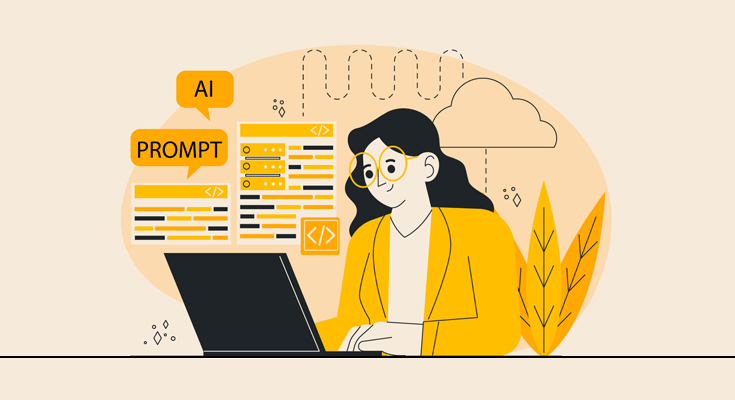AI-Driven Web Design Trends 2025: Shaping the Future of Digital Experiences
Jul 15, 2025 — AI, Web Design & Development

The world of web design is evolving faster than ever, and Artificial Intelligence (AI) is at the forefront of this transformation. In 2025, AI-driven web design isn’t just a buzzword—it’s a necessity for businesses looking to create visually stunning, highly functional, and conversion-focused websites. From automated design assistance to hyper-personalized user experiences, AI is redefining how websites are built, optimized, and maintained.
In this article, we explore the top AI-driven web design trends for 2025, the technologies powering them, and how businesses can leverage these innovations to stay ahead in the competitive digital landscape.
1. AI-Powered Website Builders Take Center Stage
In 2025, AI website builders like Shopify, Wix ADI, Bookmark, and Hostinger Website Builder, Squarespace, Webflow are becoming increasingly advanced. These platforms use machine learning algorithms to analyze industry trends, user preferences, and branding elements to create professional websites in minutes—without coding.
Key benefits:
- Instant, responsive design layouts
- Automated color and typography suggestions based on brand identity
- AI-generated content for landing pages and blogs
- Integrated SEO optimization from day one
Businesses are using these tools not only for speed but also to maintain consistency across digital channels.
2. Hyper-Personalized User Experiences
The days of one-size-fits-all websites are over. AI-driven web design in 2025 focuses heavily on real-time personalization. By leveraging predictive analytics, behavioral data, and AI-based recommendation engines, websites can adapt their design, content, and offers to each visitor’s unique preferences.
For example:
- An e-commerce store displaying personalized product recommendations based on browsing history
- Dynamic landing pages that change images, headlines, and CTAs depending on the user’s location and device
- AI-Powered Chat-bots offering tailored assistance based on customer intent
- Personalization improves user engagement, reduces bounce rates, and increases conversions—making it a must-have feature in AI-powered design strategies.
3. Voice User Interface (VUI) Integration
With the rise of voice search and devices like Alexa, Google Assistant, and Siri, Voice User Interfaces are becoming a critical part of modern web design. In 2025, AI-powered websites are integrating voice navigation for accessibility and convenience.
Voice interfaces are particularly valuable for:
- E-commerce sites allowing shoppers to search products via voice commands
- Educational platforms enabling hands-free learning
- Service-based websites where users can quickly request information
- This trend aligns with Google’s voice search optimization guidelines, making it an SEO-friendly approach as well.
4. Generative AI for Web Graphics and UI
Generative AI tools like Midjourney, DALL·E, and Runway are transforming web design workflows. In 2025, designers are using AI to generate custom illustrations, icons, background patterns, and UI elements- dramatically reducing production time.
Instead of relying on stock images, brands can create unique, on-brand visuals instantly. This helps in:
- Maintaining a consistent brand aesthetic
- Creating seasonal or event-based themes quickly
- Generating UI prototypes for faster approval cycles
5. AI-Driven A/B Testing & Conversion Optimization
Websites in 2025 are not static—they evolve continuously using AI-driven A/B testing. Instead of manually creating multiple design variations, AI tools automatically generate and test different versions of layouts, CTAs, headlines, and color schemes.
AI-based optimization platforms analyze real-time user interactions to identify high-performing elements and automatically implement winning designs.
Benefits:
- Higher conversion rates
- Reduced testing timelines
- Data-backed design decisions
6. Predictive UX and Heatmap Analysis
Understanding how users interact with a website is the most important part of the analysis. In 2025, AI tools like Hotjar AI, Crazy Egg, and Microsoft Clarity AI use predictive heatmaps to forecast where users are most likely to click or scroll.
This helps designers place critical elements like call-to-action buttons, product offers, and lead forms in optimal positions. Predictive UX ensures websites are not just visually appealing but strategically designed for user engagement.
7. AI-Enhanced Accessibility
Web accessibility is no longer optional—it’s a legal and ethical requirement. AI is playing a major role in creating inclusive web designs by:
- Automatically generating alt-text for images
- Offering real-time language translation
- Adjusting contrast, font sizes, and layouts based on user needs
- AI accessibility tools ensure compliance with WCAG (Web Content Accessibility Guidelines) and improve user
- experience for people with disabilities.
8. AI-Assisted SEO for Web Design
AI is not only improving design but also making websites more search engine friendly. In 2025, AI-driven SEO tools like Surfer SEO, Jasper AI, and RankIQ work directly with design teams to:
- Suggest keyword-rich headings and Meta descriptions
- Optimize image alt tags
- Improve website speed and mobile responsiveness
- By integrating SEO into the design process, businesses can rank higher on Google right from the start.
9. Minimalist & AI-Refined Design Aesthetics
AI is helping designers embrace minimalist yet functional layouts that prioritize clarity and speed. By analyzing user engagement data, AI recommends removing unnecessary elements that slow down load times or distract visitors.
In 2025, expect to see clean typography, whitespace usage, micro-interactions, and AI-chosen color palettes dominating modern websites.
From AI-powered website builders to predictive UX tools and voice-enabled interfaces, the digital experience is becoming smarter, faster, and more user-centric than ever. As AI continues to evolve, web designers and developers must embrace these trends to create future-ready online platforms.
Whether you’re a startup, an e-commerce brand, or a large enterprise, investing in AI-driven web design today means staying competitive tomorrow.